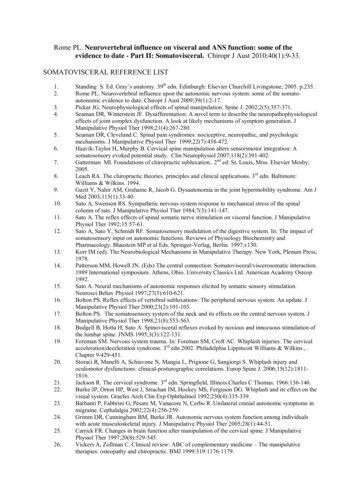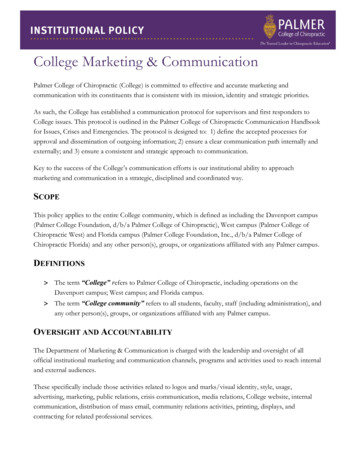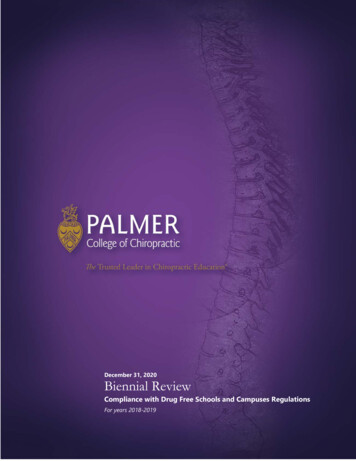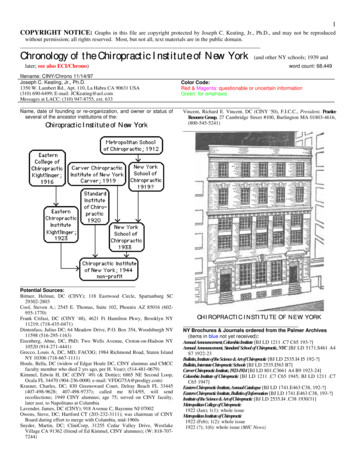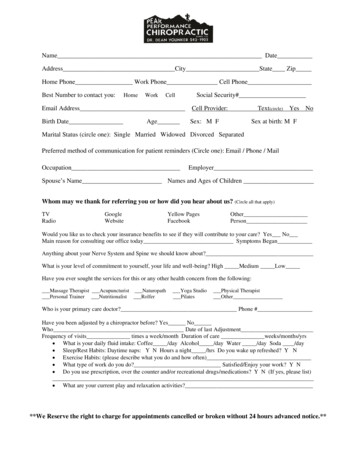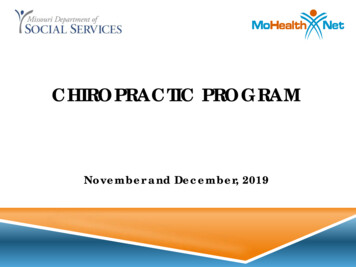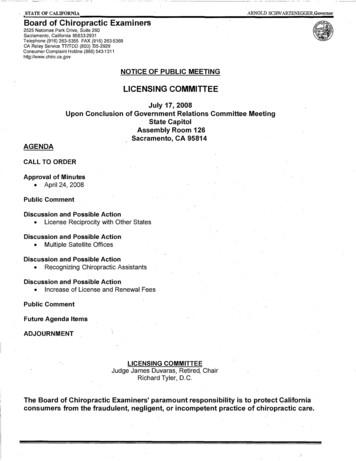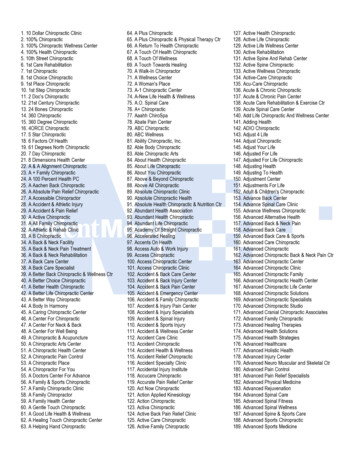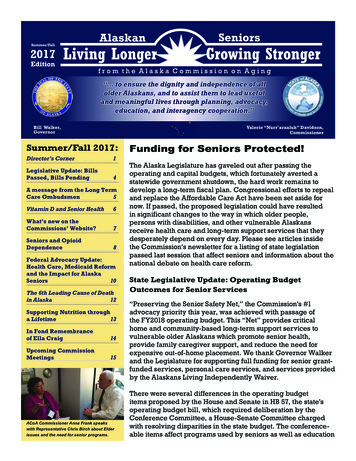
Transcription
PALMERCollegeof Chiropractic2022–2023STUDENT HANDBOOKTe Trusted Leader in Chiropractic Education
PALMER COLLEGE OF CHIROPRACTICSTUDENT HANDBOOK 2022-2023*PALMER COLLEGE OF CHIROPRACTIC (COLLEGE)Palmer College Foundation doing business asPalmer College of Chiropractic1000 Brady StreetDavenport, IA 52803(800) 722-2586(563) 884-5000Palmer College Foundation, Inc., doing business asPalmer College of Chiropractic Florida4777 City Center ParkwayPort Orange, FL 32129(866) 890-5498Palmer College of Chiropractic WestSan Jose, California90 E. Tasman DriveSan Jose, CA 95134(866) 303-7939(408) 944-6000Palmer College of Chiropractic Website: www.palmer.eduThis handbook is not intended to be, and should not be construed as, a contract betweenthe College and its students, either individually or collectively. Refer to the “Reservationof Rights” below.*RESERVATION OF RIGHTSPalmer College of Chiropractic reserves the right, without notice, to modify its requirementsfor admission or graduation; to change the arrangements or content of its courses and theinstructional materials used, or to alter any regulation affecting the student body; to refuseadmission or readmission to any student at any time, or to dismiss any student at any time,should it be in the interest of the College, or of the student, to do so. The College also reservesthe same right as to any other material in this handbook.Please refer to the Palmer College of Chiropractic website, www.palmer.edu, for the mostcurrent information.This version of the Student Handbook for Palmer College of Chiropractic also can be found onour website: www.palmer.edu.Issued for January 1, 2022 - December 31, 20231
Throughout this Handbook as a matter of convenience and consistency, the above corporateand tradenames will be more generally referred to as Palmer College of Chiropractic, PalmerCollege or the College unless denoting a particular campus.2
TABLE OF CONTENTSHISTORY. 6IDENTITY STATEMENT FOR DOCTORS OF CHIROPRACTIC . 6CHIROPRACTIC PILLARS . 6MISSION . 6VISION . 6VALUES . 6PHILOSOPHY STATEMENT. 7PRACTICE PARADIGM . 7THE PALMER EDUCATIONAL PRINCIPLES . 8THE FIVE STRATEGIC DIRECTIONS OF THE COLLEGE. 10DIRECTION 1: STUDENT LEARNING . 10DIRECTION 2: HEALTH-CARE DELIVERY. 10DIRECTION 3: SERVICE. 10DIRECTION 4: RESOURCES AND SUPPORT . 10DIRECTION 5: ADVANCING KNOWLEDGE THROUGH RESEARCH . 10COLLEGE ACCREDITATION . 11INSTITUTIONAL POLICIES . 13NOTICE OF NONDISCRIMINATION . 13STUDENT CODE OF ETHICS. 14POLICIES, RULES, PROCESSES, PROCEDURES AND/OR GUIDELINES . 14RESERVATION OF RIGHTS . 14STUDENT CODE OF ETHICS . 14PURPOSE . 14STUDENT DISCIPLINARY CODE . 15STUDENT COMPLAINT RESOLUTION PROCESS. 36INVESTIGATIONS. 37REPORTING COMPLAINTS. 38STUDENT AFFAIRS . 46GENERAL STUDENT LIFE INFORMATION. 46SUPPORT SERVICES. 50ACTIVITIES AND EVENTS. 57STUDENT CLUBS AND ORGANIZATIONS. 58ACADEMIC PROGRAMS . 61DOCTOR OF CHIROPRACTIC DEGREE MISSION STATEMENT. 61ADDITIONAL ACADEMIC DEGREE OFFERED ON PALMER’S MAIN CAMPUS 61CLINIC CAPSTONE PROGRAMS. 63ACADEMIC POLICIES . 64COURSE REMEDIATION . 65RESTRICTIONS . 66CREDIT BY EXAMINATIONS. 66GRADE CHANGES. 67GRADE POINT AVERAGE. 67GRADE REPORTS . 67ADD/DROP COURSES . 673
DEFINITION OF A CREDIT HOUR. 68COURSE PREREQUISITES AND MAINTENANCE. 68SATISFACTORY ACADEMIC PROGRESS (SAP) FOR RECIPIENTSOF FINANCIAL AID . 68ACADEMIC CREDIT LOAD. 71LENGTH OF TIME ALLOWED TO COMPLETEACADEMIC COURSE OF STUDY . 72ACADEMIC STANDING . 72COURSE AUDIT. 74NON-DEGREE STUDENTS–APPLICABLE TO THE UNDERGRADUATESTUDIES PROGRAMS ONLY. 74CLINIC PROCEDURES . 74CLINICAL COMPETENCY ASSESSMENTS . 75TRANSFER STUDENTS/ADVANCED STANDING . 75COURSE CANCELLATION POLICY. 78PROGRAM CANCELLATION . 78TECHNICAL STANDARDS FOR ADMISSION TO, CONTINUATION IN, ANDGRADUATION FROM THE DOCTOR OF CHIROPRACTIC PROGRAM. 78PROCEDURE TO REQUEST REASONABLE ACCOMMODATIONS TO MEETREQUIRED TECHNICAL STANDARDS . 79STUDENT PARTICIPATION IN TECHNIQUE AND PHYSIOTHERAPYLABORATORY/PRACTICUM SETTINGS. 79ATTENDANCE . 80MILITARY ACTIVE-DUTY NOTIFICATION . 81WITHDRAWAL FROM THE COLLEGE . 82READMISSION . 82EXAMINATION STATEMENT/EXAMINATION GUIDELINES. 83EXAMINATION SCHEDULE CONFLICTS. 84ACADEMIC INTEGRITY. 84POSTING OF ACADEMIC PERFORMANCE INFORMATION–FERPA . 84COLLEGE HONORS. 85GRADUATION . 85GRADUATION REQUIREMENTS . 85GRADUATION HONORS. 86DIPLOMA PRESENTATION. 87NATIONAL BOARD OF CHIROPRACTIC EXAMINER (NBCE)EXAM ELIGIBILITY . 88STATE BOARD EXAMINATIONS. 89FINANCIAL PLANNING . 90SCHOLARSHIPS/GRANTS. 90TUITION AND FEES. 91TUITION DELINQUENCY AND DEFERMENT . 924
TUITION REFUNDS . 94TITLE IV DEFAULT RATES. 98TUITION—DOCTOR OF CHIROPRACTIC (D.C.) PROGRAM . 98ESTIMATED COST OF BOOKS AND EQUIPMENT PER ACADEMIC TERM (D.C.PROGRAM) . 99NON-REFUNDABLE FEES (D.C. PROGRAM). 99FEES APPLICABLE TO ALL PROGRAMS. 100TUITION—BACHELOR OF SCIENCE DEGREE PROGRAM . 100CHECKS. 100LIBRARY FINES . 100FINES AND CHARGES . 100CAMPUS SAFETY . 101COMMITMENT. 101AVAILABLE INFORMATION . 101CRIME REPORTING. 101CAMPUS SECURITY. 101PALMER ALERT . 103REPORTING A MISSING STUDENT . 103SEXUAL MISCONDUCT PREVENTION AND REPORTING RESOURCES. 103EMERGENCY INFORMATION . 105EMERGENCY NUMBERS . 105EMERGENCY RESPONSE PROCEDURES. 105SEVERE WEATHER . 107FACILITIES . 108MAIN CAMPUS FACILITIES . 108FLORIDA CAMPUS FACILITIES. 111WEST CAMPUS FACILITIES . 112MAIN CAMPUS ACADEMIC CALENDAR . 114FLORIDA CAMPUS ACADEMIC CALENDAR . 116WEST CAMPUS ACADEMIC CALENDAR . 118COLLEGE ADMINISTRATION . 120CAMPUS LEADERSHIP . 120COLLEGE MANAGEMENT . 120MAIN CAMPUS ADMINISTRATION . 121WEST CAMPUS ADMINISTRATION . 121FLORIDA CAMPUS ADMINISTRATION . 122MAIN CAMPUS MAP. 123FLORIDA CAMPUS MAP . 124WEST CAMPUS MAP . 125MAIN CAMPUS DIRECTORY . 126PALMER FLORIDA DIRECTORY. 129PALMER WEST DIRECTORY. 132THE CHIROPRACTIC OATH . 1345
PALMER COLLEGE OF CHIROPRACTICHISTORYThe history of chiropractic education began at the Palmer School of Chiropractic, started bythe profession’s founder, Daniel David (D.D.) Palmer. The science, art and philosophy ofchiropractic evolved from D.D. Palmer’s years of independent research and study of humanhealth and disease. Following the successful application of his knowledge to initial patients in1895, he shared his findings with others. The first classes of the Palmer School and Cure (laterknown as the Palmer Infirmary and Chiropractic Institute, the Palmer School of Chiropracticand, finally, Palmer College of Chiropractic) were held in 1897. Palmer is chiropractic’sfounding college and is known throughout the profession as The Fountainhead. For moredetailed information visit the website at www.palmer.edu.IDENTITY STATEMENT FOR DOCTORS OFCHIROPRACTICThe primary care professional for spinal health and well-being.CHIROPRACTIC PILLARSDoctors of Chiropractic: Integrate evidence, clinical experience, and patient values and preferences Deliver expert chiropractic adjustments, manipulation and other manual treatments Embody a tradition of caring, effectiveness and patient satisfaction Collaborate and coordinate care with other health professionals Enhance patient quality of life and performance Promote vitality, wellness and patient empowerment Improve quality of life without drugs or surgery Offer readily accessible careMISSIONThe mission of Palmer College of Chiropractic is to promote learning, deliver health care,engage our communities and advance knowledge through research.VISIONPalmer College of Chiropractic strives to be The Trusted Leader in Chiropractic Education .VALUESThe Values of the Palmer College community reflect the science, art and philosophy ofchiropractic. Academic excellence Business acumen Collaboration Clinical excellence Communication Community health Critical thinking6
DiversityEvidence-based chiropractic practiceHeritage and traditionJustice, ethics and integrityLife-long learningStudent sucessPHILOSOPHY STATEMENTChiropractic is a science, art and philosophy. The philosophy of chiropractic is built upon theconstructs of vitalism, holism, conservatism, naturalism and rationalism. It provides contextfor the application of science and art.Health is a state of optimal physical, emotional and social well-being. Central to thephilosophy of chiropractic is the principle that life is intelligent. This innate intelligencestrives to maintain a state of health through adaptation mechanisms. The nervous system isrecognized as an avenue for these self-regulating processes. Interference with neurologicalfunction can impede these mechanisms, disrupt homeostatic balance and adversely impacthealth. Chiropractic posits that subluxation of the spinal column and other articulations canaffect nervous system function and the expression of health, which may result in symptoms,infirmity and disease.The understanding of the subluxation complex continues to progress from D.D. Palmer’s earlywritings about misalignment of vertebrae and other articulating structures to include additionalanatomical, physiological, biomechanical, chemical and biopsychosocial factors.PRACTICE PARADIGMChiropractic focuses on neurological and musculoskeletal integrity, and aims to favorablyimpact health and well-being, relieve pain and infirmity, enhance performance, and improvequality of life without drugs or surgery.The Doctor of Chiropractic is a primary care provider for the prevention, diagnosis andconservative management of spine-related disorders and associated locomotor conditions.Serving the patient’s best interest in a professional and ethical manner, the Doctor ofChiropractic employs experience and the best available evidence to make clinical decisions,deliver care and manage identified health concerns and conditions. In addition, doctors ofchiropractic comply with the laws and regulations governing chiropractic practice in theapplicable jurisdiction, including documentation, coding and billing practices.The practice of chiropractic includes clinically necessary: Assessments of a patient’s health status, needs, concerns and conditions by obtaining acase-appropriate history and physical examination, and by acquiring necessary imaging,laboratory or diagnostic studies; Consideration of axial (spine) and appendicular (extremity) structure and function,including subluxation, and the status of contiguous muscular and neural systems bymeans of physical evaluation, imaging and/or special test procedures; Patient-centered management consistent with the obtained history, clinical informationand diagnoses; Care coordination accomplished through goal-oriented management plans that includetreatment recommendations intended to favorably influence outcomes, prognosis, risks,behaviors and lifestyle;7
Administration of manual therapeutic procedures such as chiropractic adjustment,manipulation, mobilization or soft tissue techniques—as indicated by the history andclinical examination; Use of complimentary measures, such as passive modalities, active exercise andrehabilitation, nutritional counseling and supplementation, bracing, strapping andorthoses, and other procedures allowed under respective chiropractic practice acts; and Promotion of health, wellness and disease prevention by evaluating relevant indicatorsand risk factors, and by providing care directed at mitigating health risks and encouraginghealthy lifestyles.THE PALMER EDUCATIONAL PRINCIPLESThe following is a statement of educational principles held by Palmer College of Chiropractic,which is comprised of three campuses in:Main campusDavenport, IowaBranch campusesPalmer College of Chiropractic FloridaPort Orange, FloridaPalmer College of Chiropractic WestSan Jose, CaliforniaPalmer College of Chiropractic recognizes the need to maintain an optimum learningenvironment through a sustained commitment to excellence and continual improvement. Thefollowing reconfirms Palmer’s role as an innovative, dynamic and exciting community ofdiverse learners and scholars.1. Palmer College embraces the philosophy that life is intelligent and that the human bodypossesses an inherent potential to maintain itself in a natural state of homeostasis throughits innate/inborn intelligence. Moreover, the science of chiropractic emphasizes therelationship between structure and function, primarily that between the spinal columnand the nervous system. Implicit within this statement is the significance of the nervoussystem to health and the effect of the subluxation complex upon the nervous system and,therefore, the body.2. Palmer College is a learning community. The College is dedicated to developing,sustaining and refining a vertically and horizontally integrated chirocentric curriculumwhere excellence in teaching and learning is realized throughout the academic and theclinical experience. As the premier institution of chiropractic education, Palmer Collegeis dedicated to offering students an exceptional education through a curriculum that isdynamic in nature. Palmer College encourages students to be health-care professionalswho make a difference in the community and in the world because they have learned toobserve, think, question, imagine, serve and speak out based on the ethics they embraceand the education they have acquired. Palmer College exists to serve students and topromote student growth and development.3. Palmer College encourages its students to become life-long learners. Students interactwith administrators, faculty, staff and alumni, exposing them to the excitement oflearning and discovery.8
4. Through persistent professional leadership and competency development, students learnto appreciate and understand the complexity and diversity of human communities andthe world in which we live and work. As Doctors of Chiropractic, they will have highexpectations of their own efforts and they will see learning as extending far beyond theclassroom and clinic to their life responsibilities as health-care professionals. PalmerCollege is dedicated to teaching students how to learn.5. Palmer College expects faculty to be effective teachers, productive scholars andfocused academicians. The three are inextricably intertwined. Effective teaching overa career can only be maintained through productive scholarship. In its various forms,scholarship enhances excellence in the classroom and the clinic. Focused academicians,demonstrating mastery of a chosen field, inspire student learning. At Palmer, the facultyare competent academicians who pursue teaching as one type of scholarship. Havingcreative scholars who teach and teachers who are creative scholars fosters a learningatmosphere that is unique in chiropractic education.6. Palmer College is committed to developing the finest chiropractic clinicians. Studentsare encouraged to focus on wellness promotion, health assessment, diagnosis and thechiropractic management of the patient’s health-care needs. Palmer succeeds becauseits graduates are inspired by a broader vision using the knowledge and abilities they’veacquired to form values and to serve the common good. Students train their minds,sensibilities and abilities for a lifetime of critical, independent thought and commitmentto personal, professional and community service.7. Palmer College is committed to the advancement of the chiropractic profession. TheCollege community of administrators, faculty, staff, alumni and students are encouragedto communicate and collaborate with others in the profession. The exchange of ideas andsynergistic effect of collaborations leads to greater accomplishments for the professionthan would be possible through individual efforts. The College is dedicated to advancingawareness and appreciation of chiropractic and chiropractic education around the worldby the most efficient and effective means.8. Palmer College is dedicated to the welfare and success of its students. Through thePalmer learning experience, students are prepared to develop and refine: Lifelong learning skills and habits; Critical thinking skills; Written, verbal and listening communication skills; Leadership qualities and management skills; A sense of service to patients, the profession and the community; A consistent application of ethics in their practice of chiropractic; An ability to make substantive contributions to the interdisciplinary health-careenvironment; An ability to make a contribution to the development of a rational system of“wellness” health care; An ability to apply evidence-based reasoning in determining the needs of theirpatients; and An ability to be successful in current and emerging business management andreimbursement systems.9
THE FIVE STRATEGIC DIRECTIONSOF THE COLLEGEDIRECTION 1: STUDENT LEARNINGProvide high-quality, chiropractic-focused academic and clinical research programs for diversehealth-care settings.DIRECTION 2: HEALTH-CARE DELIVERYModel and provide chiropractic health care that is evidence-based and integrates patient valuesand clinician experience.DIRECTION 3: SERVICEPromote campus engagement, community service and professional participation.DIRECTION 4: RESOURCES AND SUPPORTEnsure and manage resources and processes in support of College programs and initiatives.DIRECTION 5: ADVANCING KNOWLEDGE THROUGHRESEARCHImprove human health by advancing knowledge through research.10
COLLEGE ACCREDITATIONThe Doctor of Chiropractic degree program at Palmer College of Chiropractic’s campuses inDavenport, Iowa; San Jose, California; and Port Orange, Florida, is awarded programmaticaccreditation by The Council on Chiropractic Education, 10105 Via Linda, Ste., 103, PMB3642, Scottsdale, AZ, 85258, Phone: (480) 443-8877, Website: www.cce-usa.org.Palmer College of Chiropractic’s campuses in Davenport, Iowa; San Jose, California; andPort Orange, Florida, are regionally accredited by The Higher Learning Commission. TheCommission can be reached by mail at 230 South LaSalle Street, Suite 7-500 Chicago, IL60604-1411 or by phone at (800) 621-7440.The College is approved for the education of veterans under Title 38 of the United StatesCode, by the Iowa State Department of Public Instruction of Veterans Affairs, and by theFlorida Department of Veterans’ Affairs for the Veterans Administration of the United States.The College is approved by the United States Immigration and Naturalization Service for theeducation of non-immigrant students.The College’s Main campus is exempt from State of Iowa registration requirements underIowa Code Section 261B.11(1) (f); however, the College has voluntarily registered theDavenport, Iowa, campus with the Iowa College Student Aid Commission as part of theCommission-approved interstate reciprocity agreement application process. Any questions astudent may have regarding this handbook may be directed to: Department of Accreditation &Licensure, 1000 Brady Street, Davenport, IA 52803 or(563) 884-5586.Palmer College of Chiropractic is approved by the National Council for State AuthorizationReciprocity Agreements (NC-SARA) which allows the College to do business in the currentSARA-member states and the District of Columbia. SARA enables the College to offerdistance education in the member states. In addition, participation in this organizationand individual state authorizations allow Palmer students to take part in supervised fieldexperiences in 49 U.S. states and the District of Columbia.Palmer College of Chiropractic’s Port Orange, Florida, campus is licensed by the Commissionfor Independent Education, Florida Department of Education. Additional informationregarding this institution may be obtained by contacting the Commission at 325 West GainesStreet, Suite 1414, Tallahassee, FL 32399-0400 or the toll-free telephone number (888) 2246684.The Palmer West Campus is approved to operate by the Bureau for Private PostsecondaryEducation. Any questions a student may have regarding this handbook that have not beensatisfactorily answered by the San Jose campus may be directed to the Bureau for PrivatePostsecondary Education at 1747 North Market Blvd., Suite 225, Sacramento, CA 95834 orP.O. Box 980818, W
Palmer College of Chiropractic West San Jose, California . 90 E. Tasman Drive San Jose, CA 95134 (866) 303-7939 (408) 944-6000 . Palmer College of Chiropractic Website: www.palmer.edu This handbook is not intended to be, and should not be construed as, a contract between
